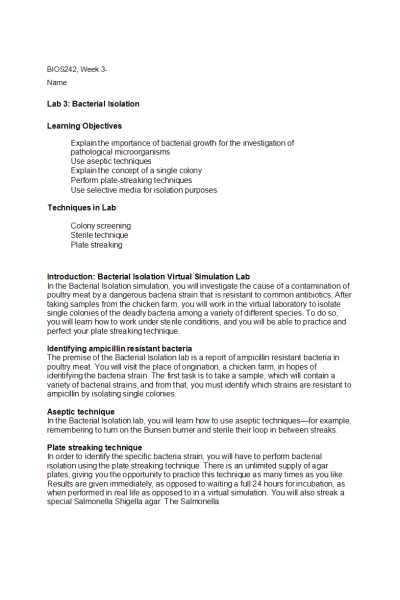BIOS 242 Week 2-OL, Lab 2; Bacterial Isolation
-
$15.00
| Institution | BIOS 242 Fundamentals of Microbiology with Lab |
| Contributor | elizabeth Oslen |
Learning Objectives
- Explain the importance of bacterial growth for the investigation of pathological microorganisms
- Use aseptic techniques
- Explain the concept of a single colony
- Perform plate-streaking techniques
- Use selective media for isolation purposes
Techniques in Lab
- Colony screening
- Sterile technique
- Plate streaking
Introduction: Bacterial Isolation Virtual Simulation Lab
In the Bacterial Isolation simulation, you will investigate the cause of a contamination of poultry meat by a dangerous bacteria strain that is resistant to common antibiotics. After taking samples from the chicken farm, you will work in the virtual laboratory to isolate single colonies of the deadly bacteria among a variety of different species. To do so, you will learn how to work under sterile conditions, and you will be able to practice and perfect your plate streaking technique.
Identifying ampicillin resistant bacteria
The premise of the Bacterial Isolation lab is a report of ampicillin resistant bacteria in poultry meat. You will visit the place of origination, a chicken farm, in hopes of identifying the bacteria strain. The first task is to take a sample, which will contain a variety of bacterial strains, and from that, you must identify which strains are resistant to ampicillin by isolating single colonies.
Aseptic technique
In the Bacterial Isolation lab, you will learn how to use aseptic techniques—for example, remembering to turn on the Bunsen burner and sterile their loop in between streaks.
Plate streaking technique
In order to identify the specific bacteria strain, you will have to perform bacterial isolation using the plate streaking technique. There is an unlimited supply of agar plates, giving you the opportunity to practice this technique as many times as you like. Results are given immediately, as opposed to waiting a full 24 hours for incubation, as when performed in real life as opposed to in a virtual simulation. You will also streak a special Salmonella Shigella agar. The Salmonella
Shigella agar contains a certain medium that only promotes growth of Gram-negative strains. Each of the different strains will exhibit a certain phenotype when grown on the Salmonella Shigella agar. By using this information you can identify the specific strain that is resistant to ampicillin. The sample will then be sent for further analysis to fully confirm the identity.
Will you be able to complete the task with your knowledge on bacterial isolation and successfully isolate the dangerous bacterial strain?
Questions:
- Purpose: Please describe in complete sentences and in your own words, the purpose of this experiment.
- Why is proper aseptic technique important in microbiology?
- What is the importance of flaming the inoculating loop or needle before and after each inoculation?
- If you do not wait 10 – 20 seconds after flame sterilizing the inoculating instruments before obtaining the sample, what might be the consequences?
- Why is it important to flame neck of the tubes immediately after uncapping and before recapping the tubes?
- Reflection: Write 5 sentences on what you learned from this simulation, what did you like and what was something that you would not prefer to be in the simulation.
| Instituition / Term | |
| Term | Summer |
| Institution | BIOS 242 Fundamentals of Microbiology with Lab |
| Contributor | elizabeth Oslen |





























